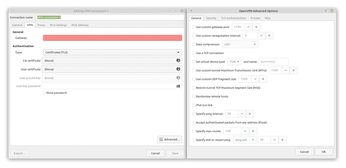Implementing Zero Trust Security
Aiming for Zero

Some old-school admins are still philosophizing about secure internal networks, but the experts have already moved on: Zero trust architectures use a reliable but complex strategy to protect the network from all threats – inside and outside.
In the third year of the coronavirus pandemic, it has now long been clear that many companies are likely to remember the virus as beneficial to their own business. VPN solution vendors definitely fall into this category: When home office and teleworking mutated from the exception to the rule in many companies, existing VPN solutions became substantially more in-demand. Hardly anyone expected the load on the VPN gateways to explode overnight. The large network manufacturers were happy to help out their customers as many admins purchased more powerful systems for OpenVPN (Figure 1).
 Figure 1: Homegrown VPN solutions, such as this one based on OpenVPN, are no longer suitable for state-of-art security. © KIT
Figure 1: Homegrown VPN solutions, such as this one based on OpenVPN, are no longer suitable for state-of-art security. © KIT
But do VPNs really solve the problem of network security? Many experts are not so sure. Implicitly, all parties involved with VPNs start from the following premise: There is a difference between the internal and the external network, and it is safe to treat internal clients differently from external clients. VPNs are regularly used specifically because admins do not want certain services to be accessible from the Internet at all. In many companies, VPNs form part of a security architecture that has grown organically over many years. Because security requirements have increased continuously over the past two decades, companies have invested more and more money in private networks and cut off more and more services from the outside world.
[...]
Buy this article as PDF
(incl. VAT)
Buy Linux Magazine
Subscribe to our Linux Newsletters
Find Linux and Open Source Jobs
Subscribe to our ADMIN Newsletters
Support Our Work
Linux Magazine content is made possible with support from readers like you. Please consider contributing when you’ve found an article to be beneficial.

News
-
Parrot OS Switches to KDE Plasma Desktop
Yet another distro is making the move to the KDE Plasma desktop.
-
TUXEDO Announces Gemini 17
TUXEDO Computers has released the fourth generation of its Gemini laptop with plenty of updates.
-
Two New Distros Adopt Enlightenment
MX Moksha and AV Linux 25 join ranks with Bodhi Linux and embrace the Enlightenment desktop.
-
Solus Linux 4.8 Removes Python 2
Solus Linux 4.8 has been released with the latest Linux kernel, updated desktops, and a key removal.
-
Zorin OS 18 Hits over a Million Downloads
If you doubt Linux isn't gaining popularity, you only have to look at Zorin OS's download numbers.
-
TUXEDO Computers Scraps Snapdragon X1E-Based Laptop
Due to issues with a Snapdragon CPU, TUXEDO Computers has cancelled its plans to release a laptop based on this elite hardware.
-
Debian Unleashes Debian Libre Live
Debian Libre Live keeps your machine free of proprietary software.
-
Valve Announces Pending Release of Steam Machine
Shout it to the heavens: Steam Machine, powered by Linux, is set to arrive in 2026.
-
Happy Birthday, ADMIN Magazine!
ADMIN is celebrating its 15th anniversary with issue #90.
-
Another Linux Malware Discovered
Russian hackers use Hyper-V to hide malware within Linux virtual machines.

